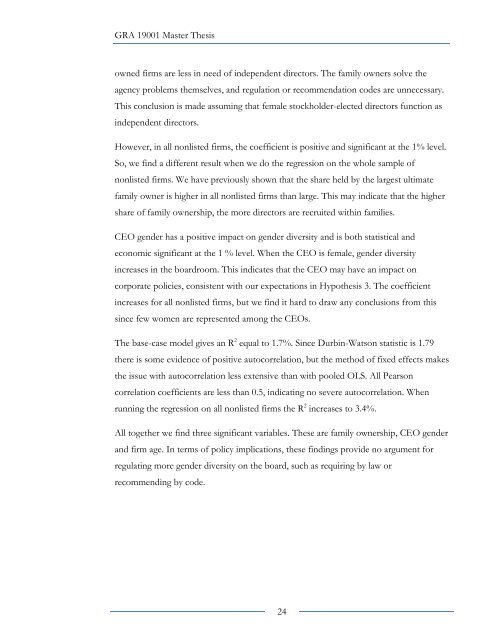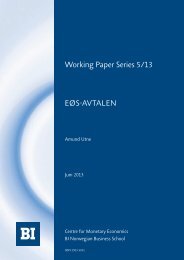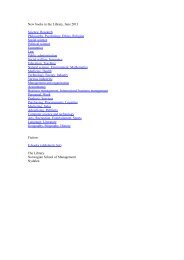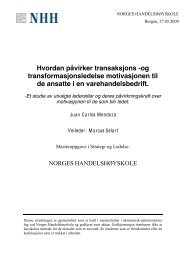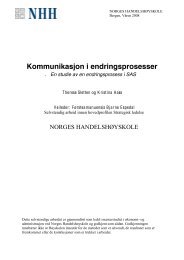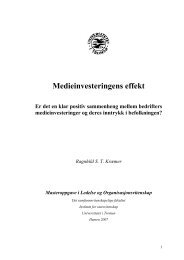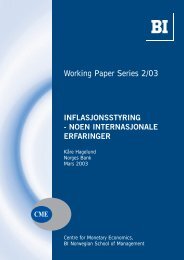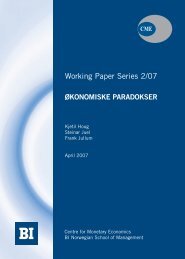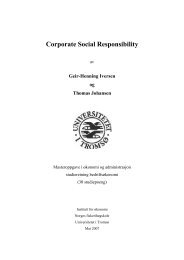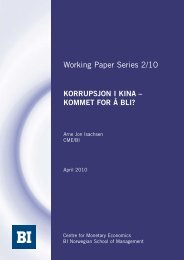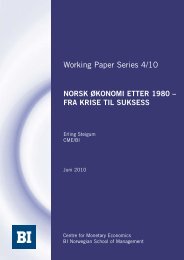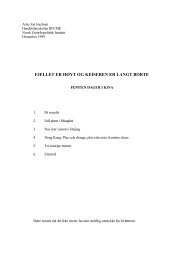Gender Diversity on the Board - BI Norwegian Business School
Gender Diversity on the Board - BI Norwegian Business School
Gender Diversity on the Board - BI Norwegian Business School
Create successful ePaper yourself
Turn your PDF publications into a flip-book with our unique Google optimized e-Paper software.
GRA 19001 Master Thesis<br />
owned firms are less in need of independent directors. The family owners solve <strong>the</strong><br />
agency problems <strong>the</strong>mselves, and regulati<strong>on</strong> or recommendati<strong>on</strong> codes are unnecessary.<br />
This c<strong>on</strong>clusi<strong>on</strong> is made assuming that female stockholder-elected directors functi<strong>on</strong> as<br />
independent directors.<br />
However, in all n<strong>on</strong>listed firms, <strong>the</strong> coefficient is positive and significant at <strong>the</strong> 1% level.<br />
So, we find a different result when we do <strong>the</strong> regressi<strong>on</strong> <strong>on</strong> <strong>the</strong> whole sample of<br />
n<strong>on</strong>listed firms. We have previously shown that <strong>the</strong> share held by <strong>the</strong> largest ultimate<br />
family owner is higher in all n<strong>on</strong>listed firms than large. This may indicate that <strong>the</strong> higher<br />
share of family ownership, <strong>the</strong> more directors are recruited within families.<br />
CEO gender has a positive impact <strong>on</strong> gender diversity and is both statistical and<br />
ec<strong>on</strong>omic significant at <strong>the</strong> 1 % level. When <strong>the</strong> CEO is female, gender diversity<br />
increases in <strong>the</strong> boardroom. This indicates that <strong>the</strong> CEO may have an impact <strong>on</strong><br />
corporate policies, c<strong>on</strong>sistent with our expectati<strong>on</strong>s in Hypo<strong>the</strong>sis 3. The coefficient<br />
increases for all n<strong>on</strong>listed firms, but we find it hard to draw any c<strong>on</strong>clusi<strong>on</strong>s from this<br />
since few women are represented am<strong>on</strong>g <strong>the</strong> CEOs.<br />
The base-case model gives an R 2 equal to 1.7%. Since Durbin-Wats<strong>on</strong> statistic is 1.79<br />
<strong>the</strong>re is some evidence of positive autocorrelati<strong>on</strong>, but <strong>the</strong> method of fixed effects makes<br />
<strong>the</strong> issue with autocorrelati<strong>on</strong> less extensive than with pooled OLS. All Pears<strong>on</strong><br />
correlati<strong>on</strong> coefficients are less than 0.5, indicating no severe autocorrelati<strong>on</strong>. When<br />
running <strong>the</strong> regressi<strong>on</strong> <strong>on</strong> all n<strong>on</strong>listed firms <strong>the</strong> R 2 increases to 3.4%.<br />
All toge<strong>the</strong>r we find three significant variables. These are family ownership, CEO gender<br />
and firm age. In terms of policy implicati<strong>on</strong>s, <strong>the</strong>se findings provide no argument for<br />
regulating more gender diversity <strong>on</strong> <strong>the</strong> board, such as requiring by law or<br />
recommending by code.<br />
24


